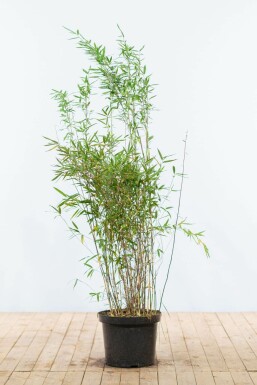


60-80

4
At Heijnen Plants, we take pride in offering the exquisite Fargesia nitida, commonly known as the Chinese fountain bamboo or simply fountain bamboo. This non-invasive clump-forming bamboo hails from the serene mountains of Northern China and is prized for its elegant and arching canes. The deep purple, almost black stems gracefully support the lush green foliage, creating a tranquil and graceful visual display. As a versatile species, Fargesia nitida can serve as a stunning solitary specimen or be cultivated to form a dense, leafy hedge, providing a touch of oriental charm to any garden setting.
























Discover the elegance and versatility of Fargesia nitida, commonly known as the Chinese fountain bamboo. This non-invasive clumping bamboo is celebrated for its graceful arching form, which resembles a fountain when mature. Adaptable to a range of soil conditions and climates, it is a splendid choice for creating a lush, evergreen hedge or as a solitary specimen that adds an exotic touch to the garden.
Fargesia nitida originates from the mountainous regions of Northern China, thriving under the canopy of tall trees, which makes it well-suited to partially shaded areas in your garden.
We would like to provide some tips on how to plant and care for a Fargesia. By following these tips, you can be sure to enjoy your Fargesia for a long time.
For optimal growth, >bamboo nitida prefers a location with partial shade, though it can also tolerate full sun if provided with sufficient moisture. The site should offer protection from harsh afternoon rays to maintain the vibrant coloration of its foliage and stems. Well-drained soil is essential to prevent waterlogging, which can be detrimental to the plant's root system. This species demonstrates remarkable winter hardiness, enduring temperatures as low as -20.6°C, corresponding to USDA zone 6a. The versatile nature of this evergreen allows it to adapt to various soil types, provided they are properly drained.
When planting Fargesia nitida, choose a location with partial shade to sun that accommodates its growth rate of 50 to 75 cm per year. This species thrives in any well-drained soil type. With a root ball system, it's essential to prepare a planting hole twice the width of the root mass and of equal depth. Ensuring the root ball is level with the soil surface promotes proper establishment. After planting, water thoroughly to settle the soil and eliminate air pockets. Mulching can help retain soil moisture and regulate temperature, vital for maintaining the lush, green vibrancy of the foliage throughout the seasons.
Pruning Fargesia nitida is minimal, typically requiring attention only once per year to maintain its shape and vigor. The best time for this task is late winter or early spring before new growth begins. During the pruning process, it is advisable to remove any dead or weak canes at the base to encourage fresh, healthy shoots. This species, with its rapid growth rate, quickly regenerates, ensuring a dense and vibrant hedge or solitary display throughout the year, even after pruning.
The evergreen Fargesia nitida requires consistent moisture to maintain its lush greenery, particularly during its rapid growth phase where it can increase in height by 50 to 75 cm annually. While it is not drought-resistant, overwatering should be avoided by ensuring the soil is well-drained. During the warmer months or in full sun, increase the frequency of watering to compensate for higher evaporation rates. In winter, cautiously reduce watering, but never allow the root ball to completely dry out, especially considering its winter hardiness down to -20.6°C, making it suitable for USDA zone 6a climates.
To ensure the robust growth and lush greenery of bamboo Fargesia nitida, fertilization is key. Apply a balanced, slow-release fertilizer early in the spring to kick-start the growing season. The nutrient boost supports the species' rapid growth rate and helps establish the dense foliage desired in a hedge or solitary display. A second application during the summer can further sustain its development and maintain the vibrant green and purple hues of the stems.
Avoid over-fertilizing, as excessive nutrients can lead to weak growth and diminish the plant's overall hardiness. A careful approach to fertilization, complemented by the species' natural resistance to cold, down to -20.6°C, will contribute to a healthy, evergreen presence in a range of garden settings.
Fargesia nitida thrives without the invasive traits typical of some bamboo species, making it an excellent choice for gardeners seeking non-spreading clumps. Its elegant arching canes and fine-textured leaves create an alluring aesthetic as a standalone specimen or as a serene privacy screen. Moreover, this species tolerates a range of light conditions, from full sun to partial shade, offering flexibility in garden design and placement.
To maintain the health and vigor of Fargesia nitida, division is a vital gardening practice. Ideally carried out in the more temperate conditions of spring or autumn, the process begins with the plant being carefully lifted from the soil. Afterward, gardeners should separate the clump into smaller portions, ensuring each has a sufficient root system. Replanting these sections promptly will rejuvenate growth and ensure the bamboo continues to provide a dense, evergreen screen. This method of propagation not only stimulates new growth but also helps control the size and spread of the plant, suitable for its use as a hedge or solitary feature.
Fargesia nitida, with its graceful, non-invasive clumping habit, is the quintessential choice for those seeking an elegant, hardy bamboo. It thrives in partial shade, making it a versatile addition to any garden composition. Its lush foliage and refined stature provide year-round beauty, enhancing the serenity of your outdoor space.
